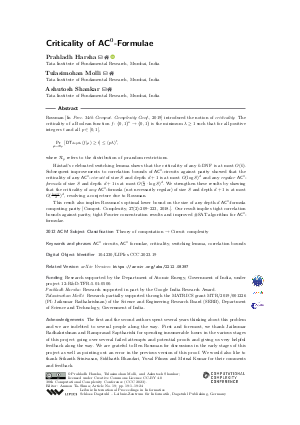@InProceedings{harsha_et_al:LIPIcs.CCC.2023.19,
author = {Harsha, Prahladh and Molli, Tulasimohan and Shankar, Ashutosh},
title = {{Criticality of AC⁰-Formulae}},
booktitle = {38th Computational Complexity Conference (CCC 2023)},
pages = {19:1--19:24},
series = {Leibniz International Proceedings in Informatics (LIPIcs)},
ISBN = {978-3-95977-282-2},
ISSN = {1868-8969},
year = {2023},
volume = {264},
editor = {Ta-Shma, Amnon},
publisher = {Schloss Dagstuhl -- Leibniz-Zentrum f{\"u}r Informatik},
address = {Dagstuhl, Germany},
URL = {https://drops.dagstuhl.de/entities/document/10.4230/LIPIcs.CCC.2023.19},
URN = {urn:nbn:de:0030-drops-182898},
doi = {10.4230/LIPIcs.CCC.2023.19},
annote = {Keywords: AC⁰ circuits, AC⁰ formulae, criticality, switching lemma, correlation bounds}
}

 Creative Commons Attribution 4.0 International license
Creative Commons Attribution 4.0 International license
